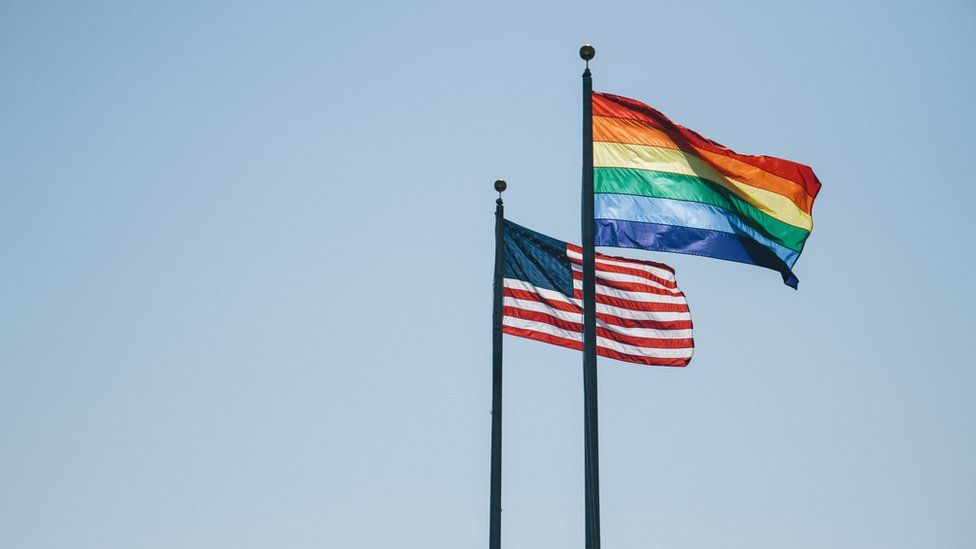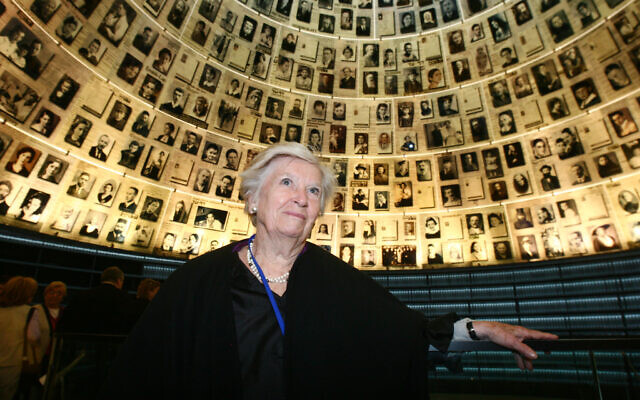By Leo Sands
BBC News

Kuwait has summoned a top US diplomat in protest over tweets from the American embassy supporting LGBT rights, its foreign ministry says.
US officials there had posted a rainbow flag and message of solidarity from President Joe Biden for Pride month.
But Kuwait officials criticised the embassy for "supporting homosexuality" and demanded it didn't happen again.
Rights for LGBT people are severely restricted in Kuwait and it is illegal there for men to be gay.
In a pair of tweets published in English and Arabic on Thursday, the US Embassy in Kuwait quoted President Biden as saying all humans "should be able to live without fear no matter who they are or whom they love".
The post, published to mark the beginning of Pride Month, appeared with a picture of a rainbow flag symbolising LGBT rights.
The BBC is not responsible for the content of external sites.
Hours later, Kuwait's Foreign Ministry said it rejected what had been published and had summoned the US Charges d'Affaires James Holtsnider to hand him a memorandum condemning the posts.
According to its statement, the Foreign Ministry ordered the embassy to respect Kuwaiti laws and "not to publish such tweets".
Kuwaiti officials accused the embassy of violating international conventions requiring diplomats to "respect the laws and regulations of the receiving state".
Many conservative Kuwaiti Twitter users responded with similar outrage to the US embassy's Pride post, including MP Osama Al-Shaheen who wrote: "The behaviour of the American embassy is unacceptable."
"Foreign embassies must respect the public order of Kuwait and its official religion," he added.
Another Kuwaiti social media user accused US officials of "imposing a diseased and decadent culture on our conservative Muslim society".
Rights for LGBT people are extremely limited in socially conservative Kuwait - one of 69 countries in the world where being gay is criminalised.
According to the Gulf state's penal code, men who have same-sex relations can be punished by up to seven years in prison.
Until this year, it was a criminal offence in Kuwait to be a trans person. A court has now overturned the law as unconstitutional.
The US State Department is yet to respond from an emailed request from the BBC for comment.

US Embassy To Vatican Again Flies Pride Flag
By CNA
By Kevin J. Jones
The U.S. Embassy to the Holy See has again flown a Pride Flag, as President Joe Biden reiterated his commitment to supporting LGBT advocacy and, apparently, transgender-affirming health care for children.
“The United States respects and promotes the equality and human dignity of all people including the LGBTQIA+ community,” the U.S. embassy to the Vatican said on Twitter June 1. It showed a photo of its Pride Flag and used several hashtags including “All Inclusive.”
The acronym LGBTQIA+ stands for lesbian, gay, bisexual, transgendered, queer, intersex. The “a” stands for “asexual,” an identity inconsistently used in other U.S. government statements, while the plus sign stands for other varieties of self-professed sexual identity.
The message differs slightly from last year’s, when the embassy said the U.S. “respects the dignity and equality of LGBTQI+ people.”
The U.S. Embassy to the Holy See showed the Pride Flag last year as well.
In early 2021 U.S. Secretary of State Antony Blinken announced that U.S. embassies and consulates around the world could fly the Pride Flag on the same flagpole as the American flag, during “Pride season.”
That authorization to fly the flag, which was not a mandate, was given ahead of May 17, observed by activists as the international day against homophobia, transphobia, and biphobia.
Blinken’s cable on Pride Flags, first reported by Foreign Policy magazine in April 2021, advised that diplomatic posts in certain countries should avoid flying the rainbow flag if doing so would create a backlash.
The U.S. Embassy to Italy similarly displayed a Pride Flag and various messages on its Twitter page, including a link to President Joe Biden’s May 31 declaration of Lesbian, Gay, Bisexual, Transgender, Queer, and Intersex Pride Month.
“Today, the rights of LGBTQI+ Americans are under relentless attack,” Biden said, adding, “An onslaught of dangerous anti-LGBTQI+ legislation has been introduced and passed in States across the country, targeting transgender children and their parents and interfering with their access to health care.”
Biden did not specify the legislation, but some states have raised concerns that children are wrongly being exposed to sexual propaganda or wrongly face pressure to undergo purported gender transitions, beginning with puberty blockers.
The president said 45% of self-identified LGBTQI+ youth seriously considered attempting suicide last year, saying this is “a devastating reality that our Nation must work urgently to address.”
“Today and every day, my Administration stands with every LGBTQI+ American in the ongoing struggle against intolerance, discrimination, and injustice,” he said, rejecting violence against self-identified LGBTQI+ people.
“We reaffirm our belief that LGBTQI+ rights are human rights,” Biden’s message said.
Biden again called on Congress to pass the Equality Act, legislation which would establish sexual orientation and gender identity as protected classes in federal civil rights law alongside race and sex. The legislation would also override the limited religious freedom protections of the Religious Freedom Restoration Act.
The U.S. Conference of Catholic Bishops has warned that despite the bill’s stated aims of combatting discrimination, it would discriminate against people of faith who are opposed to the redefinition of marriage and to transgenderism.
The USCCB has warned that the bill, by mandating access to public accommodations based on one’s sexual orientation or gender identity, could be used to pressure churches to “host functions that violate their beliefs.” Religious adoption agencies could be forced to match children with same-sex couples, and faith-based women’s shelters could be required to house biological males identifying as transgender females.
U.S. government promotion of Pride Month has differed depending on the president.
Under the Trump administration, U.S. diplomatic outposts were reportedly prohibited from flying the rainbow Pride Flag from embassy flagpoles, and had to obtain special permission to do so. They were allowed to display the flag inside buildings.
During the Obama administration, the U.S. Embassy to the Holy See made pro-LGBT social media posts on the international day against homophobia, transphobia, and biphobia and during “Pride Month” in 2014 and in 2011.
The embassy also made a pro-LGBT Facebook post for “Pride Month” in 2017 during the Trump administration.
The U.S. State Department is funding LGBT advocacy throughout the world through its Global Equality Fund. Its multiple country partners include Italy. Non-government partners to the fund include the Human Rights Campaign and the Arcus Foundation, funded by billionaire heir Jon Stryker.
Stryker’s foundation has backed Christian LGBT groups and others which reject Christian teaching on marriage and sexual morality and seek to create cultural and doctrinal change within various denominations. Its grantees include Methodist groups which recently helped split the United Methodist Church over issues including sexuality.
Another U.S. State Department effort is the Global LGBTQI+ Inclusive Democracy and Empowerment Fund. The GLIDE Fund accepts funding requests for various projects, including those which seek to increase religious leaders’ support for self-identified LGBTQI+ people.
The promotion of LGBT causes can conflict with Christianity and other religions. In October 2015 Archbishop Charles Palmer-Buckle said Great Britain had sought to link financial aid to Ghana’s legal recognition of same-sex unions as marriages.
The Russian Orthodox Patriarch Kirill of Moscow, controversial for his support of President Vladimir Putin’s invasion of Ukraine, has sought to connect pushback against LGBT advocacy to Russia’s war on Ukraine. He depicted Pride parades as a loyalty test to Western governments and to “the so-called values that are offered today by those who claim world power.”
In February 2022, Gallup reported that 7.1% of Americans now identify as LGBT. Of these, 57% identified as bisexual. Some 6% of all women respondents told Gallup they were bisexual, compared to 2% of men. The percentage of self-identified LGBT respondents was particularly high among younger generations. Surveying of self-identified LGBT respondents has caused debate over accuracy, given the possibility of respondent errors and sampling size problems. There is also debate over whether sexual self-identification in young people will persist as they age.

CNA
The Catholic News Agency (CNA) has been, since 2004, one of the fastest growing Catholic news providers to the English speaking world. The Catholic News Agency takes much of its mission from its sister agency, ACI Prensa, which was founded in Lima, Peru, in 1980 by Fr. Adalbert Marie Mohm (†1986).













_fitted.png)